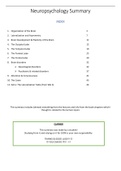Summary
Summary Neuropsychology/Neuropsychology, VU year 2
- Course
- Institution
- Book
Summary of all lectures notes & examples from the Neuropsychology course, year 2 VU psychology studies. Also includes summary of (almost) all the chapters of Fundamentals of Human Neuropsychology by Kolb & Whishaw.
[Show more]




